Julie & Julia: A Cooking Movie Review

The screenplay, penned by director Nora Ephron, is not just the biography of Julia Child--it is mingled with a year long cooking/blogging adventure undertaken by Julie Powell in 2002. Powell challenged herself to spend a year cooking all the recipes from Julia Child’s first cookbook, Mastering The Art of French Cooking
I knew going in to the theater that I would see some semblance of a biographical tale, but I was surprised to walk out having enjoyed a romantic comedy. Meryl Streep’s Julia Child and Stanley Tucci’s Paul Child were depicted as very much in love with each other and with life. Their ability to laugh at life’s twists and turns and at Julia’s culinary mistakes made for an inspirational piece.
The dishes depicted in the movie were all real recipes from Julia Child’s cookbook, and I mentioned to Rick several times in the movie that I wanted to try particular recipes, especially the beef bourguignon. I wonder how it would taste in cast iron?
If you enjoy cooking, whether in cast iron or not, I think you’ll enjoy the delightfully charming Julie and Julia.
Rick's note: If you look closely at the pans Julia Child's character is using in the movie, in addition to her trademark copper pots, she also uses quite a few Le Creuset enameled cast iron dutch ovens.
Feel free to leave your thoughts in the comments below, or you can contact Kathy directly at kathy@cookingincastiron.com.
Tip: Baking in Cast Iron is for More than Cornbread

The other night a couple told Kathy and me, “We need to have you come over and show us how to do more with our skillet than just make corn bread.”
Oh where to even begin?
But many folks who use their cast iron regularly, don’t realize how versatile something like a skillet is for ordinary baking.
When it comes to baking and cast iron, I’m convinced of two things:
- Food tastes better in cast iron. If you’ve ever had macaroni and cheese baked in a cast iron skillet or a casserole cooked in a dutch oven instead of a traditional casserole pan of aluminum or glass, you know what I mean. Cast iron provides a texture to the outer layer of food that just can’t be duplicated in other pans.
- Baking is VERY “healthy” for your cast iron’s seasoning. If you only use your skillet on the stove top, you will probably have to re-season it (at least the inside bottom of the pan) more often than you will if you’re using it inside the oven, too.
Feel free to leave your thoughts or ask questions in the comments below, or you can contact Rick directly at rick@cookingincastiron.com.
Skillet Banana Cake

Many afternoons were spent down at the Jarrell’s house, playing with Brian (he had more games on his Atari 2600 than I did) or in the small thicket of woods between our houses where he and I built a three-level tree house (It sounds much more elaborate than the actual reality). Another advantage to hanging around the Jarrell house rested in the fact that Sharon Jarrell (pictured above) was a fantastic cook. In fact, she was well known for her cooking, often catering events and publishing her own cookbooks.
Recently, I was going through some recipes that we simply categorize as “family recipes.” When you live next to someone long enough, they count as family. This particular recipe of Sharon’s caught my eye because it specifically called for an “old iron skillet.” I had never made the recipe and couldn’t even remember if I’d ever had it before. Kathy and I have made it twice in the last month or so, and I can only tell you that it is incredible. It tastes wonderful hot out of the oven or cold out of the refrigerator.
Sadly, Sharon Jarrell is no longer physically with us, but she left behind a rich cooking legacy, and I remember her whenever I make any of her recipes such as the one below.
CAST IRON REQUIRED:
- an “old” 10.25” cast iron skillet (if yours is not old, a new cast iron skillet will work just fine).
- a second, smaller skillet (or sauce pan)
CAKE INGREDIENTS
- 1 1/4 cup sugar
- 1 1/2 cup flour
- 1 teaspoon soda
- 4 tablespoons buttermilk
- 2 eggs
- 1 stick butter
- 1/2 teaspoon salt
- 1 teaspoon vanilla
- 1 cup mashed banana
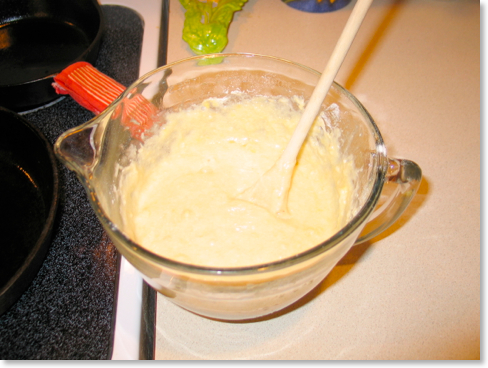
Mix all ingredients together and pour into old iron skillet. Bake at 350º for about 30 minutes.
While the cake is baking, get the topping ready.
TOPPING
- 1 cup pecans - (slightly toasted)
- 5 tablespoons brown sugar
- 3 tablespoons butter
- 3 tablespoons cream or evaporated milk
- 1 teaspoon vanilla
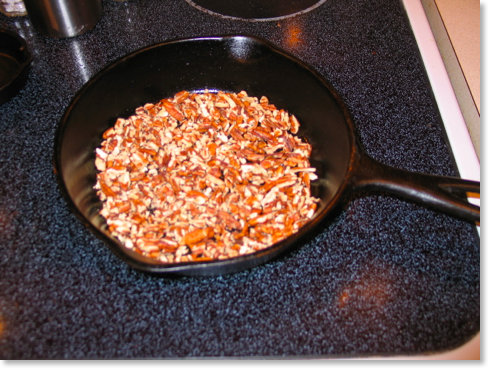
Bring all topping ingredients to a boil.
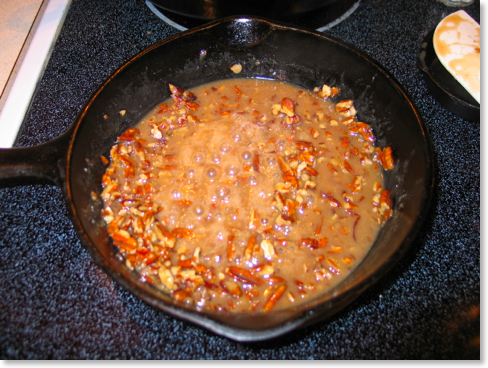
Pour over cake when it comes out of the oven. Return to oven and broil to bubbling. Watch to keep from burning.
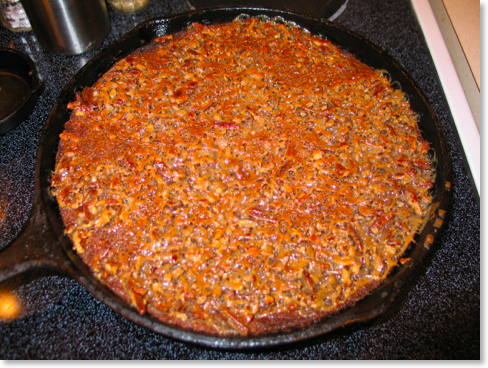
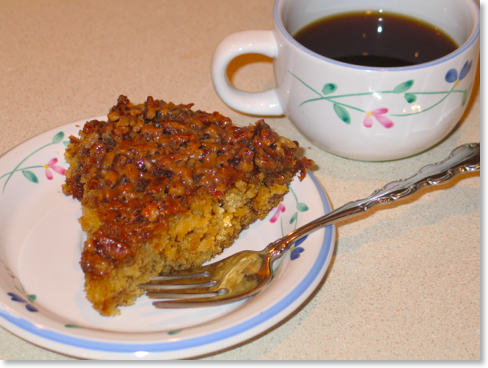
Enjoy!![]() MacGourmet users, click image to download recipe (or simply drag image to your MacGourmet recipe box).
MacGourmet users, click image to download recipe (or simply drag image to your MacGourmet recipe box).
Feel free to leave your thoughts or ask questions in the comments below, or you can contact Rick directly at rick@cookingincastiron.com.
![]()
Mimi's Biscuits
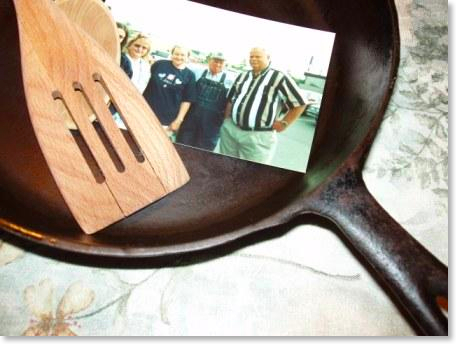
She made quick work of the biscuits, unceremoniously cutting lard into flour before dousing it with buttermilk to knead into the mix. With the dough formed in the bowl, she would roll the ball out onto the mat and pat it out on a frosting of flour. Next she would pull a small metal cutter out of her cluttered utensil drawer to portion the biscuits. With a sharp jerk of her knee, she could shift the weight in the drawer and slide the pieces back into their confines enough to force the drawer back into place. Before long, the biscuits have found their way to a baking sheet and into the oven.
Next her attention would turn to the refrigerator; with one hand on the door and a back crooked just enough to peer inside, she would search the crowded shelves for a package of sausage. In a moment she located it and placed her hands upon its half-frozen contents. She muttered a question about the age of the meat and wondered when they’d get that fridge fixed so everything in the back of it wouldn’t have to be thawed out before she could cook it. She breathed a sigh of resignation, dismissed the thought and moved to the sink with the package in hand. She took a step backward and simultaneously bent forward to open the cabinet below the sink where she would pull a skillet from the assortment stashed haphazardly.
The old skillet was heavy and greasy to the touch, but the sturdiness of this cast iron piece was unparalleled in her kitchen. How many times had she used this particular skillet and browned meat or scrambled eggs or mixed red eye gravy for her family? It seemed somehow ironic that the years showed on her face well before they started to show on this skillet. Still, she was comforted; despite the wear and accumulated grease on the outside, the inside was smooth, shiny and conditioned for its task. Once upon the heat, it would react quickly and evenly. She still had something of that tendency in her, she mused.
Soon the sausage was sizzling and popping. My grandmother took her wooden spoon to the skillet, pushing the meat about with determination as the first pangs of hunger were starting to reach her stomach. My grandfather was now seated at the table in anticipation of the morning’s repast after having taken the walk up the gravel road to the mailbox and to retrieve the paper. He was stirring his instant coffee in a chocolate-colored mug chipped on both its rim and handle. A faint coffee ring was beginning to form where droplets had trickled down the side of the mug.
He cleared his throat and commented on the sale paper’s announcements for the day. “They’ve got butter half off at the Piggly Wiggly. And looks like it’s two for one on Cokes.”
My grandmother nodded and mentioned she wanted to stop by the nursery for some flowers this afternoon--if they went out. She’d been wanting to get herself a hollyhock lately. She asked if Ronnie had gotten there yet. He was easing down the driveway even as she inquired and soon entered the room with an amplified “Mornin’” to be heard by the household.
Uncle Ronnie was deaf in one ear. Since my grandparents were also slowly going deaf, the general decibel level of the household had increased two fold in recent years. Each morning on his way to the woods, Ronnie would amble in for breakfast. After a little conversation, a cigarette, a satisfied stomach, and a glance at the paper, he would climb into his tractor trailor and drive a great distance to the patch of land that he would be clear cutting for the day. If a piece of equipment had broken the day before, he and my grandfather would debate the best means of eradicating the problem, which would often entail a special trip to a hardware store. My grandfather would generally accompany my uncle either way.
He and Ronnie would push back energetically from the table, leaving it and the chairs sticky with honey or jam, blackened with coffee stains and cigarette ashes, in order to get on their way and begin their work. And once they departed, my grandmother would sigh with a different sort of resignation, hum a familiar melody, and begin the ritual of cleaning up after breakfast.
Feel free to leave your thoughts in the comments below, or you can contact Leila directly at leila@cookingincastiron.com.
Can I Use Cast Iron on a Glass Top Range?

I often have people email me asking if it’s okay to use cast iron with glass top ranges. Some range manufacturers include warnings against using cast iron with their products. And the RangeKleen fryer we reviewed last year had a warning against its use on a glass surface. Of course, we ignored that, and I’ll tell you why below.
What’s the big deal about cast iron and glass (or even ceramic) surfaces? Well, glass can get scratched. We live in such an over-protective culture that we often throw the baby out with the bath water when it comes when it comes to erring on the side of judgment. For instance, many schools have gotten rid of playground equipment because some children might get hurt on it. I got hurt on playground equipment when I was a kid, but I promise you, I’d rather have had it than to not have it. Ladder companies tell us not to use that top step as a step because some people have been reckless enough to do it and have gotten hurt. I wonder how long before you can’t buy a ladder. And just try finding a diving board for a backyard pool these days. You can find one, but it’s getting difficult.
Anyway, companies that make glass top ranges don’t want you to call them up complaining about how easily their surfaces get scratched, so they simply tell you not to put anything heavy on it-- especially cast iron! By the way, the heaviness of cast iron could also cause your glass top range to break if you dropped a pan, so this is another concern with the company.
Now, I don’t want you to call me up complaining about your scratched or broken range top either, but I can tell you that IF (this is a big if) you are careful, you can use a glass top range or stovetop with no problems. In fact, if you notice in most of my pictures, such as the one above, Kathy and I have a glass range right now. In reality, I much prefer a gas range, but this is just where we live right now and we’ve made do.
I can tell you that we use cast iron all the time on our glass top range. Cast iron works great on a glass top range. In fact because a glass range heats evenly and cast iron heats evenly, it’s a pretty good match. I would even guess that today, gas ranges are probably in the minority for most kitchens even though most of us who really “get into” cooking prefer them.
If you have a glass top range, let me offer a few suggestions for keeping it unscratched (and unbroken!) and in tip-top shape.
- Keep you range top CLEAN. Usually what scratches your range top is some kind of abrasive substance between the surface and your pan. Also, make certain that your cleaner is specifically designed for the range you have. Usually the manufacturer recommends specific cleaners. If yours doesn’t, check on the label of the product you are buying. Glass range cleaners can usually be found at appliance stores, home improvement stores, discount stores and more.
- By the same token, keep the bottom of your pan clean. If you’ve got gunk building up on the bottom of that pan, know that it can damage a smooth surface range.
- Don’t slide cast iron around on the surface. Sliding any pan around--cast iron or otherwise--is going to eventually leave marks on the surface of your range. Pick it straight UP. Which, of course, leads to...
- Set cast iron down gently onto your smooth-top cooking surface. If you’ve ever been burned by a pan coming out of a 400° oven, you know how easy it is to simply drop it on the floor or your range top. Use both hands and use pot holders that are thick enough. I’ve learned the hard way that those little mitts that fit over the the skillet handle is not enough protection for a pan that has been in a hot oven for any period of time. I also feel that the short handle on newer skillets across from the regular handle is genius. This really helps the cook use both hands when handling a hot skillet.
Feel free to leave your thoughts or ask questions in the comments below, or you can contact Rick directly at rick@cookingincastiron.com.
Coming to Terms with Pre-Seasoned Cast Iron
If you have many discussions with true cast iron aficionados, you may find a wide variety of opinions on a number of subjects: the “proper” method for seasoning cast iron, soap or no soap when cleaning, old cast iron vs. new cast iron, and much more. But if you really want to start an argument in some circles, bring up the subject of manufacturer pre-seasoning. For the uninitiated, there was once a day when all “new” cast iron came gun metal gray. Nowadays, that’s almost impossible to find because nearly all new cast iron comes already nice and black since it’s been “pre-seasoned” from the manufacturer, usually with a sprayed on vegetable oil concoction.
And for the extremely uninitiated, when someone refers to seasoning in cast iron circles, it’s a reference to the black coating that builds up overtime on a cast iron pan. This coating, or patina, is the product of the carbonization of oils and creates a natural non-stick surface on a pan. This is why a cast iron skillet or other pan actually improves with age as opposed to chemically treated non-stick pans which generally get worse as they get older.
I just ran an informal inventory of our cast iron. We have roughly 29 cast iron cooking items, or 30 if you count my Sportsmans Grill. In that count, I’m not including lids (even though I bought at least one separately) or novelty items such as the little ashtray-size skillet that we use for a spoon rest. With a couple of exceptions, all of our cast iron items are pans we actually use on a fairly regular basis. In other words, we don’t get into collecting cast iron for the sake of collecting. I’m not knocking that, mind you; nor am I saying I’d never do that. We simply don’t have the room for that right now.
Now of the 29 or 30 cast iron items we have, 16 came pre-seasoned from either Lodge or Santé. But that wasn’t always the way it was. My first piece of cast iron was a Lodge 10.25” skillet given to me in the mid-nineties by my mother. it came completely unseasoned, so I had to season it myself. I can’t remember what kind of oil I used on that first attempt, but I do recall that it was a disaster. Through trial and error, I eventually got it right. As many of you can no doubt relate, the more I used that cast iron skillet, the more I wanted to use cast iron for just about all my cooking. My second cast iron item was obvious. I needed a dutch oven to cook my gumbo. Somehow, I just instinctively knew gumbo would taste better in cast iron--and I was right!
I requested a dutch oven for Christmas and I received TWO that were exactly the same with one exception. One was pre-seasoned and one was not. As pre-seasoned cast iron really just came into vogue in the early part of this decade, many companies at the time offered both pre-seasoned and bare items side-by-side in the same stores. Seeing pre-seasoning as a bit of a novelty, and remembering my initial experience with my skillet, I opted to keep the pre-seasoned dutch oven and sell the bare cast iron dutch oven. I later regretted this decision.
What’s the big deal with pre-seasoning? Well, it tends to eventually come off the pan. Take for example, the lid pictured below of my Lodge 2 qt. Serving Pot
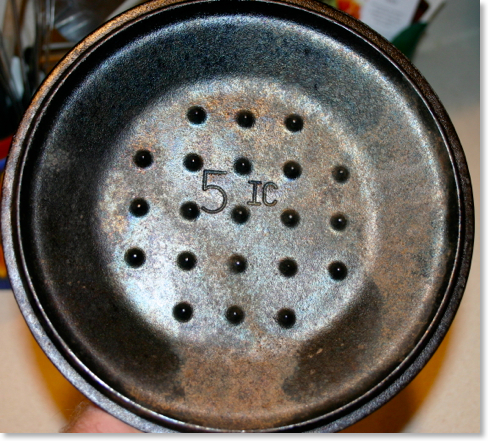
You can see how faded the pre-seasoning has become. Believe it or not, that was after only two uses! I’ve re-seasoned it myself since, and it’s doing fine. I’d also point out that in my experience, a pre-seasoned pan doesn’t normally lose its seasoning quite so quickly. But this is typical of what often happens eventually to a pre-seasoned cast iron pan. And if it doesn’t fade, the pre-seasoning chips off. Of course, pre-seasoning is not dangerous to someone’s system as a chemical non-stick surface like Teflon might be. In fact, the pre-seasoning treatment that Lodge uses is even certified Kosher!
Nevertheless, when pre-seasoning began to fade or chip in the past, I used to get very frustrated. I really felt (and still do) that I can season a pan better myself. But try finding a major cast iron brand that still offers pans that aren’t pre-seasoned. They’re near non-existant. Now my frustration is fairly mild compared to some. Since Lodge has decided to no longer sell non-pre-seasoned pans, I’ve actually heard some folks say they’ll never buy Lodge again. In my opinion, this is extreme, although no one can argue with the cooking ability of a 100-year-old Griswold skillet or other older pan which becomes the only other alternative to pre-seasoned pans.
Regardless, my frustration with pre-seasoning has become a thing of the past. Yes, I’d rather season a pan myself, but I’ve come to terms with pre-seasoning, and my acceptance has come for a number of reasons.
1. Pre-seasoned pans aren’t really a new innovation.
Not too long ago, I was looking through Smith & Wafford’s The Book of Wagner & Griswold (the red book) when something very interesting caught my eye in this photograph below on p. 9.
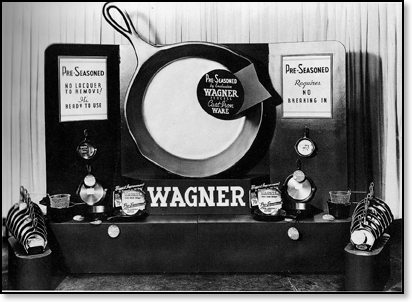
There’s no date on the picture, but I would guess that it was from the 1940s or 50s, if not earlier. Notice the advertising on these Wagnerware pans. The main selling point for these pans is that they were pre-seasoned. Thus, I find it hard to throw stones at any cast iron company that pre-seasons today--whether that’s Lodge, Camp Chef/Santé, RangeKleen or any other company--because evidently, the idea’s been around for quite a while. Who knows if your prized decades-old skillet that you obtained second hand wasn’t pre-seasoned to begin with!
2. All regularly used cast iron will (probably) have to be re-seasoned.
Let me offer a lesson I learned from my grandmother’s skillet. When my grandmother moved into an assisted living home a few years back, I inherited her 10.25” skillet pictured below.
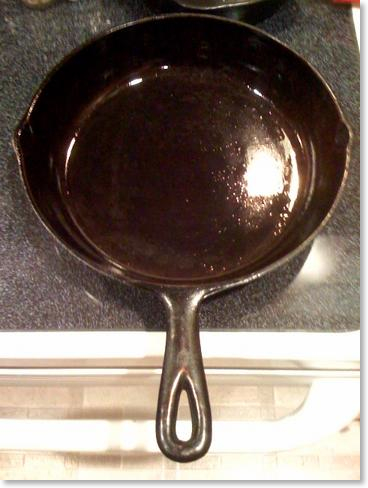
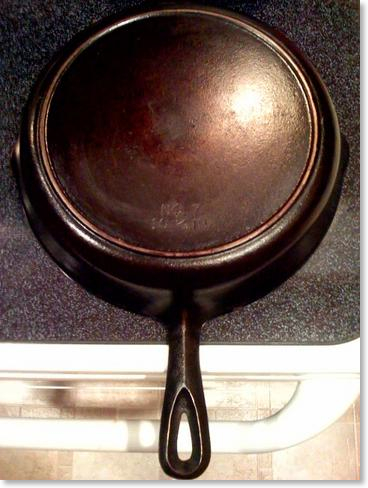
I don’t know exactly how old this skillet is. My grandfather tells me she had it their entire married life. They were married 71 years before she died in 2008. If it was brand new when they got married, it’s well over 70 years old. But if it was a hand-me-down, it’s much older. I have no idea what brand it is. It only says “NO. 7" and "10 1/4 IN.” on the back. It’s my prized possession of all my cast iron simply because it was my grandmother’s. If you told me I could only keep one piece of my cast iron, I would pick this one--even though I use it second to my Lodge skillet that was my first cast iron pan. Furthermore, when I received this skillet, it honestly had the nicest seasoning I’ve ever seen on any piece of cast iron. The inside bottom is as smooth as glass. I wish I could sit down and talk to my grandmother about this pan, but of course, I can’t now.
Now, you need to know that I take really good care of my cast iron. I never wash with soap. I treat every pan with a fresh coat of olive oil to prepare it for its next use. I never stack pans, and I’m very careful to avoid metal utensils when cooking in them.
However, one day I noticed that my grandmother’s pan was starting to lose its seasoning on the inside bottom. I was shocked! How could this happen? Then guilt set in. I felt embarrassed, ashamed. Knowing that there is no heartache in heaven, I at least found some relief in the fact that she didn’t know.
The reality is, though, that more than likely she had to re-season her pan every now and then. Granted, she and I used her pan differently. She probably didn’t cook overly acidic foods in her pan like chicken marsala (which uses red wine), and I don’t remember her cooking spaghetti sauce all that often in her skillet. Further, while I primarily use olive oil in my pan and occasionally bacon grease; my grandmother primarily used bacon grease, and if she wasn’t using that, she was probably using Crisco!
She also used her pan multiple times a day back and forth between the stovetop and the oven. In the morning, bacon and eggs were cooked for the whole family. She might use it at lunch as well. Sometime in the afternoon, the pan was used for cornbread, cooked in the oven. Then, in the evenings, it was used again for the family dinner. This constant use, multiple times a day, going back and forth between the stovetop and her oven, was incredibly “healthy” for this skillet. And frankly, none of my pans gets this kind of constant use. But I am firmly convinced that this back and forth between the stovetop and oven was a key for keeping such a quality seasoning on the pan.
Since I had to partially re-season my grandmother’s pan (I only concentrated on the inside bottom, using lard for seasoning), I’ve stopped using it for overly acidic foods. But the main point here is that even the best of pans--pre-seasoned or not--have to be re-seasoned every now and then.
3. Pre-seasoning gives folks new to cast iron a head start.
That statement isn’t original to me, and I wish I could find the source. But I remember reading those words one day on someone’s website, and it all just kind of fell into place for me. For many “modern” cooks, bare cast iron can be a real challenge. I know it was for me, but I fell in love with cast iron and was determined to persevere. But with people’s busy schedules, it’s easier for many folks to simply grab a chemically treated non-stick pan, especially if a cast iron pan is going to necessitate a lot of preparation beforehand. I’ve said it before, but I’m firmly convinced that whether one likes pre-seasoning or not, its mainstream use today has been a major factor in the cast iron renaissance that we have witnessed as home cooks (and many professional chefs and celebrity chefs) have realized grandma was right to begin with and have returned to using cast iron.
Further, when I was in South Pittsburg, Tennessee, touring the Lodge Manufacturing plant last summer, I asked a Lodge employee why they no longer offered bare cast iron. Her answer was rather interesting. She said that for a while they offered both. But she said that when put side-by-side on store shelves, the pre-seasoned iron outsold the bare iron by a wide margin. And when their pre-seasoned cast iron sold out, they found that customers would buy other brands that were pre-seasoned over their bare cast iron offerings. That was enough of an answer to make sense to me. Lodge is the last American foundry in existence. I don’t exclusively use their cookware, but I use a lot of it, and I’d hate to ever lose them the same way that other great cast iron companies disappeared over the last few decades.
Two Suggestion for Cast Iron Manufacturers
- Most cast iron cookware comes with a brief set of instructions for care and maintenance. I feel it would be a good idea to also include instructions for re-seasoning cast iron in case the pre-seasoning fades or flakes. Lodge includes re-seasoning instructions on their website, but it might not be a bad idea to include them with the product as well. I shudder to think of perfectly good pans getting thrown out, but I bet it happens.
- Since Lodge is the only cast iron company with a US factory, they might be the only ones who could actually implement this second suggestion. I think it would be a great idea if those of us who prefer bare cast iron were allowed to special order it and have a pan taken from the line before it has the pre-seasoning process applied. Although it seems a bit backwards when I really think about it, I would actually be willing to pay a few dollars more to be able to place a special order and receive my cast iron bare. Then I could season it myself.
Feel free to leave your thoughts or ask questions in the comments below, or you can contact Rick directly at rick@cookingincastiron.com.





